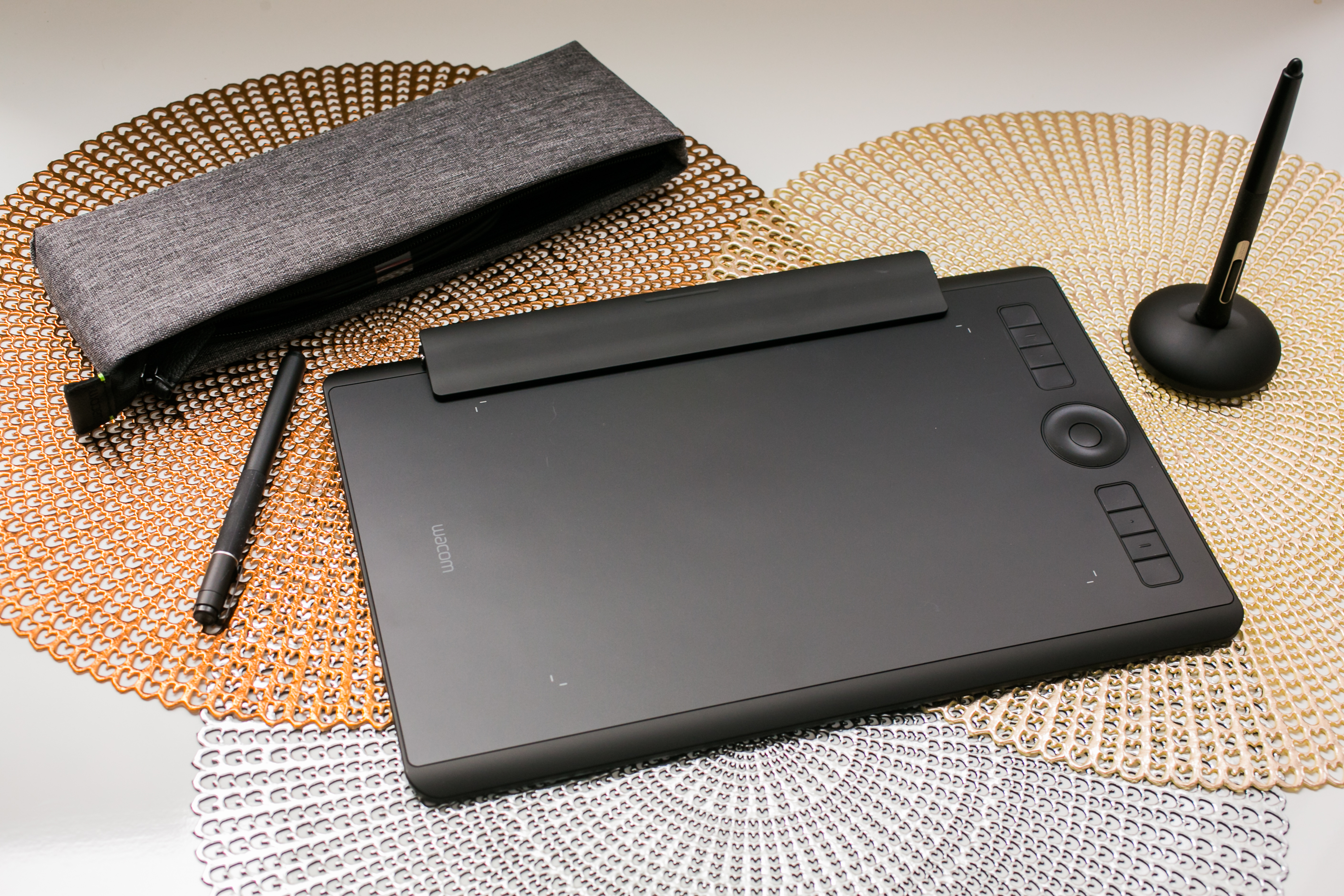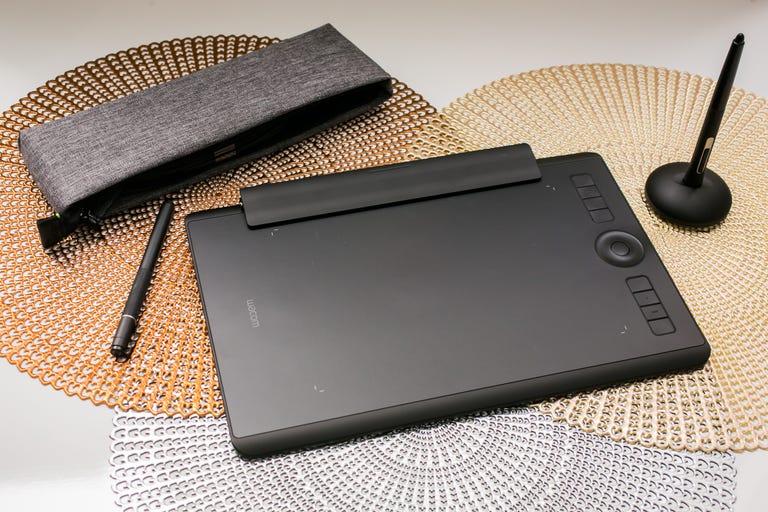 Why You Can Trust CNET
Why You Can Trust CNET Wacom Intuos Pro (2017) and Intuos Pro Paper review: For slick sketches or deranged doodles, this is your pen tablet
The class-leading graphics tablet for professionals has some smooth new moves.
When the Intuos Pro graphics tablet was announced at CES 2017, it sounded a little ho-hum. The reality is way better.
The Good
The Bad
The Bottom Line
For the uninitiated, Wacom's Intuos (and Bamboo) tablets connect as input devices to your computer, adding pressure-sensitive drawing and painting as well as serving as a touchpad. Like its sister MobileStudio Pro product line of Windows tablets, one highlight of the 2017 Intuos Pro, which uses the same Pro Pen 2, is that it supports 8,192 levels of pressure and 60 degrees of tilt recognition, the most to date. (The actual resolution hasn't changed, though, remaining at 5,080 lines per inch/100 lines per millimeter.)
The other cool update is a new Paper edition, which includes an EMR-supporting finepoint gel pen. With it, you can draw on any paper while disconnected -- it stores up to 200 drawings in the tablet's built-in memory -- and then connect to sync your drawings to its cloud service using the company's Inkspace app. The strokes are captured in Wacom's Ink Layer Language (WILL), which allows for text recognition and exporting as a vector format from Inkspace.
Pricing
| Intuos Pro (medium) | Intuos Pro (large) | Intuos Pro Paper Edition (medium) | Intuos Pro Paper Edition (large) | |
| US | $350 | $500 | $400 | $550 |
| UK | £330 | £450 | £380 | £500 |
| Australia | AU$500 | AU$550 | AU$550 | AU$770 |
You can also turn the Intuos Pro into the Paper edition after the fact by purchasing the add-on kit with the pen and clip (though you can DIY your own clip). And the older Intuos Pro Pen & Touch model is still around if you want a small, as the latest version doesn't come in that size.
Wacom redesigned the tablet to occupy less space but retain the same active area, plus it added a power button and dedicated touch on/off switch, and the new stand is more elegant looking. It still stores the extra nibs, but has a new, clever system for replacing them. You can also buy Texture Sheets to obtain a smoother or rougher feel.
It connects via USB-C or built-in Bluetooth, and you pair it by holding down the center button for 6 seconds or so. A blinking blue light appears on the right side to indicate that it's in pairing mode.
Otherwise, it's pretty much the same as before, with a set of eight ExpressKeys and a Touch Ring, which can perform one of four functions based on the toggle status of the center button, and there's an onscreen menu with another eight functions. Everything's programmable on both global and individual application levels.
Putting pen to paper
For people who prefer starting out with sketches on paper, the Paper Edition is really cool. You attach a stack of up to 10 sheets of paper to the tablet with the bundled clip -- while you can stick any size paper on it, it only works on the center portion -- and when it senses the gel pen in proximity it goes into recording mode. A big blue cross appears on the toggle button when there's content waiting to be synced, and you initiate syncing by pressing it. When the buffer's clear, it turns green. Double tapping the button creates a new layer.
The primary benefit of the company's electromagnetic resonance (EMR) technology is that it doesn't require a battery to power the pen; that's doubly important with an ink pen. After all, who wants to have to replace the batteries in it? But that means you can't use any old ink replacement in it. It comes with three ink refills and a 10 pack of A5/letter or A4/half-letter size sheets (depending upon your tablet size) in addition to the 10 nibs for the Pro Pen. Additional refills come in a five-pack for $10 (£14; I can't find them on the Australian site, but the US price directly converts to AU$13).
Note that you don't have pressure sensitivity with the ink pen, which makes sense technologically, but if you use multiple strokes to create thicker lines (without lifting the pen) you can end up with some odd, complex paths.

The complete Paper Edition includes the Intuos Pro tablet and stylus plus a clip, gel pen with special ink that works with Wacom's EMR technology and a carrying case for the accessories.
I was thrilled when Wacom introduced the gel pen: there are only ballpoints with the smart folios and I really dislike ballpoints. It's a black 0.4mm finetip, though, which doesn't glide quite as smoothly as the 0.7mm I'm used to. But it's a good compromise between fine and thick, and I didn't see any railroading. It would be great if this was just the first in a line of different sized pens. If you are a ballpoint lover, there's one of those, too, for $100 (£90; I can't find it on the Australian site, but the US price directly converts to about AU$130).
The big gotcha: Wacom rates the Finetip Pen cartridge for only 10 pages of "moderate sketching" on the medium tablet's A5-size active area, which means less on the large tablet. (In contrast, the ballpoint lasts for about 100 pages.)
If you're a longtime Intuos user, the operation will feel very familiar: no big changes in that respect, and while the Pro Pen 2 looks a little different, the feel is fundamentally the same, with the same buttons on the wide barrel and rubberized grip. One of those not-changes includes the tendency of the tablet to get scratched up from regular stylus usage, though that doesn't impact tablet performance.
I did experience problems with Bluetooth initially -- nothing would see the tablet when I attempted to pair or reconnect -- but it turns out the internal settings can get corrupted. Pro tip: to fix, stick the end of a small paper clip (or the reverse end of a nib) into the tiny hole next to the power button and press for about 10-15 seconds until the power light goes off. This resets the internal memory, so any unsynced sketches will be erased as well.
The battery seems to last about a day of general use, and Wacom rates it for 10 hours of continuous sketching, but it probably varies widely depending upon what you're doing.
The hardware is willing, the software not so much
The extra levels of pressure help deliver a smoother, more natural feel than with previous models. But the fact remains that there's still no software that explicitly supports the added sensitivity, so I can't say whether the theoretical benefits will actually materialize. If that's what you're looking for you should probably wait until the support's in and the driver glitches have been worked out -- because there are always driver glitches.
There's also still lag within applications such as Photoshop when using large or complex brushes, but otherwise I had no issues with precision or behavior, even over Bluetooth. Your mileage may vary, though.
The driver offers a gazillion ways to customize all the controls; so many that it sometimes seems an overwhelming task. But I wish there were a way to customize hover distance: how close to the tablet the stylus needs to be before the tablet accepts pen input. I tend to keep the pen in my hand while using the touch gestures, and I think it frequently gets confused while receiving touch input with the pen tip so close. And occasionally I get ghost-in-the-machine behavior where scrolling goes wild; my favorite is when the brush size independently zooms back and forth from maximum to minimum in Photoshop. Decreasing the Touch Ring sensitivity helped.
However, I really don't like the Inkspace app. It does the job -- syncing and manually exporting -- but I'd like it to do either more or less. For instance, I really don't want my document/sketch repository to live with Wacom; I'd rather it would perform the WILL translation automatically and pass it to my Creative Cloud library or preferred cloud storage service based on my setting choices. I don't need yet another cloud account. And it's only free for the first 5GB of storage. Most annoying, it only syncs via USB on the desktop -- Bluetooth syncing's available on iOS and Android.
Expensive, but worth it
The experience using the latest version of the Intuos Pro is much better than before, if only for the improved feel, built-in wireless connection and smaller footprint, plus the paper sketching capability. Older non-ink Intuos Pens are compatible, so you don't have to repurchase your faves. And it's still an essential buy for creatives who do a lot of digital freehand sketching, inking, masking and so on. But if you're looking for enhanced pressure sensitivity over the previous model's 2,048 levels, you might want to watch and wait.


